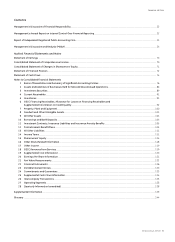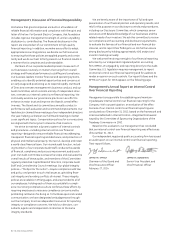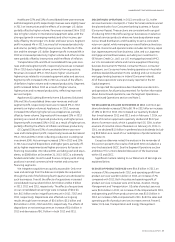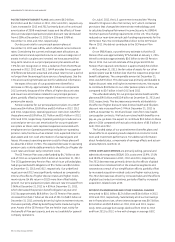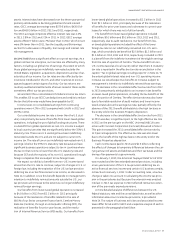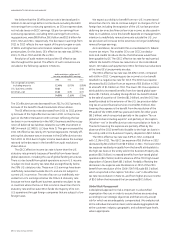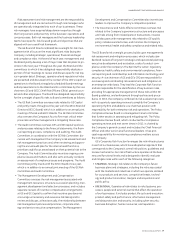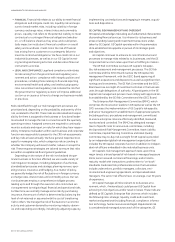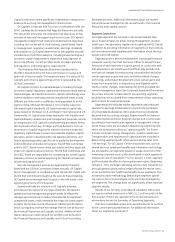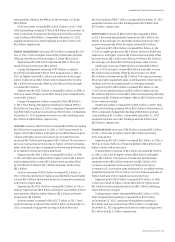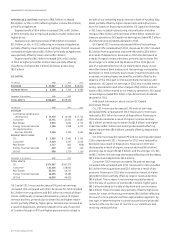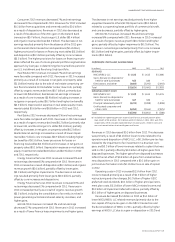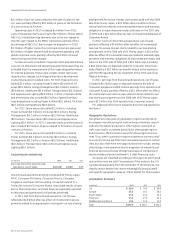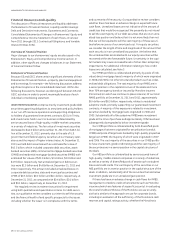GE 2013 Annual Report Download - page 40
Download and view the complete annual report
Please find page 40 of the 2013 GE annual report below. You can navigate through the pages in the report by either clicking on the pages listed below, or by using the keyword search tool below to find specific information within the annual report.
’
38 GE 2013 ANNUAL REPORT
We believe that the GE effective tax rate is best analyzed in
relation to GE earnings before income taxes excluding the GECC
net earnings from continuing operations, as GE tax expense does
not include taxes on GECC earnings. GE pre-tax earnings from
continuing operations, excluding GECC earnings from continu-
ing operations, were $8.8 billion, $9.5 billion and $12.6 billion for
2013, 2012 and 2011, respectively. The decrease in earnings from
2011 to 2012 refl ects the non-repeat of the pre-tax gain on sale
of NBCU and higher loss amortization related to our principal
pension plans. On this basis, GE’s effective tax rate was 18.9% in
2013, 21.3% in 2012 and 38.3% in 2011.
Resolution of audit matters reduced the GE effective tax
rate throughout this period. The effects of such resolutions are
included in the following captions in Note 14.
Audit resolutions—effect on GE
tax rate, excluding GECC earnings
2013 2012 2011
Tax on global activities
including exports (2.4)% (0.7)% (0.9)%
U.S. business credits (0.6) — (0.4)
All other—net (1.0) (0.9) (0.7)
(4.0)% (1.6)% (2.0)%
The GE effective tax rate decreased from 2012 to 2013 primarily
because of the benefi t of audit resolutions shown above.
The GE effective tax rate decreased from 2011 to 2012 primar-
ily because of the high effective tax rate in 2011 on the pre-tax
gain on the NBCU transaction with Comcast refl ecting the low
tax basis in our investments in the NBCU business and the recog-
nition of deferred tax liabilities related to our 49% investment in
NBCUniversal LLC (NBCU LLC) (see Note 2). This gain increased the
2011 GE effective tax rate by 19.7 percentage points. Partially off-
setting this decrease was an increase in the GE effective tax rate
from 2011 to 2012 due to higher income taxed above the average
rate and to the decrease in the benefi t from audit resolutions
shown above.
The GECC effective income tax rate is lower than the U.S.
statutory rate primarily because of benefi ts from lower-taxed
global operations, including the use of global funding structures.
There is a tax benefi t from global operations as non-U.S. income
is subject to local country tax rates that are signifi cantly below
the 35% U.S. statutory rate. These non-U.S. earnings have been
indefi nitely reinvested outside the U.S. and are not subject to
current U.S. income tax. The rate of tax on our indefi nitely rein-
vested non-U.S. earnings is below the 35% U.S. statutory rate
because we have signifi cant business operations subject to tax
in countries where the tax on that income is lower than the U.S.
statutory rate and because GECC funds the majority of its non-
U.S. operations through foreign companies that are subject to low
foreign taxes.
We expect our ability to benefi t from non-U.S. income taxed
at less than the U.S. rate to continue subject to changes of U.S. or
foreign law, including the expiration of the U.S. tax law provision
deferring tax on active fi nancial services income, as discussed in
Note 14. In addition, since this benefi t depends on management’s
intention to indefi nitely reinvest amounts outside the U.S., our
tax provision will increase to the extent we no longer indefi nitely
reinvest foreign earnings.
As noted above, GE and GECC fi le a consolidated U.S. federal
income tax return. This enables GE to use GECC tax deduc-
tions and credits to reduce the tax that otherwise would have
been payable by GE. The GECC effective tax rate for each period
refl ects the benefi t of these tax reductions in the consolidated
return. GE makes cash payments to GECC for these tax reductions
at the time GE’s tax payments are due.
The GECC effective tax rate was (13.6)% in 2013, compared
with 6.6% in 2012. Comparing pre-tax income to a tax benefi t
resulted in a negative tax rate for 2013. The GECC tax expense
decreased by $1.5 billion from an expense of $0.5 billion in 2012
to a benefi t of $1.0 billion in 2013. The lower 2013 tax expense is
attributable to increased benefi ts from low-taxed global oper-
ations ($1.7 billion), including the signifi cant tax benefi t related
to the sale of a portion of Cembra ($1.0 billion), and the 2013 tax
benefi ts related to the extension of the U.S. tax provision defer-
ring tax on active fi nancial services income ($0.3 billion). Also
lowering the expense is the benefi t from the resolution of the
IRS audit of the 2008–2009 tax years and items for other years
($0.1 billion), which is reported partially in the caption “Tax on
global activities including exports” and partially in the caption
“All other—net” in the effective tax rate reconciliation in Note 14.
The items lowering the expense are partially offset by the
absence of the 2012 benefi t attributable to the high tax basis in
the entity sold in the Business Property disposition ($0.3 billion).
The GECC effective tax rate was 6.6% in 2012, compared
with 12.1% in 2011. The GECC tax expense of $0.5 billion in 2012
decreased by $0.4 billion from $0.9 billion in 2011. The lower 2012
tax expense resulted principally from the benefi t attributable to
the high-tax basis in the entity sold in the Business Property dis-
position ($0.3 billion), increased benefi ts from low-taxed global
operations ($0.2 billion) and the absence of the 2011 high-taxed
disposition of Garanti Bank ($0.1 billion). Partially offsetting the
decrease in tax expense was the absence in 2012 of the 2011
benefi t from resolution of the 2006–2007 IRS audit ($0.2 billion),
which is reported in the caption “All other—net” in the effective
tax rate reconciliation in Note 14, and from higher pre-tax income
of $0.3 billion that increased the tax expense ($0.1 billion).
Global Risk Management
A disciplined approach to risk is important in a diversifi ed
organization like ours in order to ensure that we are executing
according to our strategic objectives and that we only accept
risk for which we are adequately compensated. We evaluate risk
at the individual transaction level, and evaluate aggregated risk
at the customer, industry, geographic and collateral-type levels,
where appropriate.





